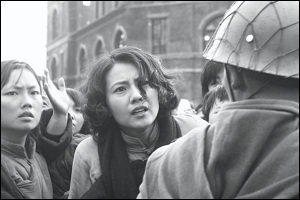The Nanjing Massacre
The Nanjing Massacre
L. Quart: City of Life and Death
 CITY OF Life and Death, directed by Lu Chuan, takes place in 1937, six months after the beginning of the Sino-Japanese War. It begins with the Japanese capturing Nanjing (formerly known as Nanking)—the then-capital of the Republic of China. The Japanese forces proceed to execute prisoners of war and loot from, rape, and murder civilians, including aged men, women, and children, in what is now known as the Nanjing Massacre. The massacre would claim an estimated 300,000 Chinese lives in just six weeks.
CITY OF Life and Death, directed by Lu Chuan, takes place in 1937, six months after the beginning of the Sino-Japanese War. It begins with the Japanese capturing Nanjing (formerly known as Nanking)—the then-capital of the Republic of China. The Japanese forces proceed to execute prisoners of war and loot from, rape, and murder civilians, including aged men, women, and children, in what is now known as the Nanjing Massacre. The massacre would claim an estimated 300,000 Chinese lives in just six weeks.
The film provides little historical context or explanation for the massacre, which was the violent culmination of years of enmity between Imperial Japan and China. Thousands of victorious, young, battle-worn Japanese soldiers had been raised and trained within the xenophobic social order of an empire that had never before occupied a foreign capital. Emperor Hirohito had declared that the Imperial Army was not subject to war crimes laws, which resulted in barbarism without constraint. In fact, German businessman and Nazi Party member John Rabe, who was working in Nanjing, was so repelled by the brutality of the Japanese occupiers that he wrote to Hitler, asking if the Führer would do something to stop them. Predictably, Hitler did nothing to endanger his relation with an ally.
Lu Chuan’s film closely follows the account in Iris Chang’s 1997 book, Rape of Nanking, but he also makes use of two years of research from sources including the diaries of Western witnesses, brought to life in the film with the American missionary Minnie Vautrin and the aforementioned German businessman, Rabe; survivor testimony from the few Chinese nationals who lived to relate their experiences; and another group of survivors, old veteran Japanese soldiers, who were less inclined to share their memories of unchecked aggression at Nanjing. He also used the diaries and correspondence of a number of participants who played a role—both as soldiers and victims—in the massacre.
The research stirred Lu to try to move away from the one-dimensional view held by many Chinese of the Japanese as savages. He wanted to make a film where his children could look at the Japanese in another way. In his words, “I found the basic truth that a massacre is not a special talent of the Japanese people….That devil is always in everyone’s heart, so as human beings we need to be very careful. It’s not just a tragedy for the Chinese killed in Nanjing, it’s a tragedy for the Japanese soldiers who killed them.”
However, it’s the Japanese troop’s murderous ferocity that is at the core of this widescreen, black-and-white film. The Japanese are portrayed burning people alive, beheading Chinese soldiers and hanging their heads on poles, gang-raping women, stacking dead naked prostitutes in a cart, and throwing children from windows. Incredibly, the horrors pile up without Lu ever indulging in sensationalism; the Japanese troops’ criminal acts just become part of the fabric of Nanjing’s monstrous daily life.
The film’s strength lies in those indelible images—some of them evoking shocking acts, others beautifully composed long scenes, silently conveying the profound despair of war. The film also contains carefully choreographed, crosscut battle scenes (shot with a handheld camera) and dramatic, tight close ups that capture a variety of deeply felt emotions—almost always agonizing ones among City of Life and Death’s large cast of characters.
At first the characters blur together, and even after they emerge as individuals the film rarely expresses more than a superficial view of who they are. The film succeeds more in capturing the fate of the occupied population of Nanjing than in illuminating the individuals who inhabit it. However, there are exceptions, like Mr. Tang (Fan Wei), Rabe’s shambling and sad-eyed assistant, who tries to protect his family by making deals with the Japanese, and Miss Jiang (Gao Yuanyuan), a beautiful teacher who with other Chinese and a few foreigners works heroically to protect those who have taken refuge in a safety zone set up in the shattered city. But it’s not long before the Japanese troops hunting for wounded Chinese soldiers hiding there overrun the zone and round up a hundred Chinese women to serve sexually the troops.
However, if the Japanese are the barbaric aggressors, Lu tries to achieve some balance by focusing on the point of view of a young Japanese soldier named Kadokawa (Hideo Nakaizumi). The sensitive, virginal Kadokawa moves through the action as a silent witness whose sense of shock and anguish intensifies until he can bear no more and commits suicide. There are other unsettling moments in the film where Japanese soldiers and officers display their humanity. One soldier on patrol, unable to stomach what he sees, breaks rank and screams out his desire to go home.
Lu’s aim, like Clint Eastwood’s in Letters From Iwo Jima, is to make an antiwar film—to project something about the murderous madness of all wars—and he does just that. But he also brings to life an event that the Japanese refused to acknowledge at the end of the Second World War—a silence left mostly unchallenged by the Chinese. The film is still not being shown in Japan, but this emotionally moving work provides one more striking addition to a slew of recent films on the brutality of war.
Leonard Quart is the co-author of the fourth edition of American Film and Society Since 1945 and a contributing editor of Cineaste.






